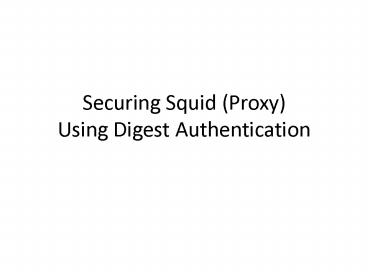Securing Squid (Proxy) Using Digest Authentication - PowerPoint PPT Presentation
Title:
Securing Squid (Proxy) Using Digest Authentication
Description:
Securing Squid (Proxy) Using Digest Authentication Authenticasi Method in Squid The user credentials can be passed from the web browser to the proxy in several ways. – PowerPoint PPT presentation
Number of Views:61
Avg rating:3.0/5.0
Title: Securing Squid (Proxy) Using Digest Authentication
1
Securing Squid (Proxy)Using Digest Authentication
2
Authenticasi Method in Squid
- The user credentials can be passed from the web
browser to the proxy in several ways. These
methods are called authentication schemes. - Squid supports the following schemes
- basic. This is the oldest and most insecure
scheme. User name and password are transferred in
clear text and can be read by anyone who can
access the transferred data. You need to be aware
of this and decide if this is acceptable in your
environment. - digest. This a better, more secure
authentication scheme. Instead of passing the
password in clear text, this scheme uses a hash
based on the password and several other
parameters. - NTLM. NTLM is a protocol that is used in several
Microsoft network implementations to enable
single sign-on across different services. Squid
supports NTLM for proxy authentication, although
it is not an official HTTP extension.
3
Recommendation
- Usually digest is the best choice, because it is
a standardized and rather secure authentication
scheme. However, the current Squid versions
(2.5.x) require the passwords to be available in
clear text on the system running the proxy in
order to create the correct digest hash. This
makes it difficult to integrate Squid into an
existing authentication environment where
passwords are usually only stored as a hash of
the actual password. Future versions of the Squid
package (starting with version 3.0) will most
likely support encrypted passwords for the digest
authentication scheme.
4
Installation
- apt-get install squid apache2
- vim /etc/squid/squid.conf
- find a string INSERT INSERT YOUR OWN RULE(S)
HERE TO ALLOW ACCESS FROM YOUR CLIENTS
5
Insert A Code
- Code in after the INSERT.
- auth_param digest program /usr/lib/squid/digest_pw
_auth -c /etc/squid/password - auth_param digest children 2000
- auth_param digest realm pens
- auth_param digest nonce_garbage_interval 5
minutes - auth_param digest nonce_max_duration 30 minutes
- auth_param digest nonce_max_count 50
- auth_param digest post_workaround off
- acl password proxy_auth REQUIRED
- acl jarkom src 10.252.108.0/255.255.255.0
- http_access allow jarkom password
6
Creating password Restarting Daemon
- htdigest -c /etc/squid/password pens idris
- (entry your password)
- /etc/init.d/squid restart
7
Testing
- Open your browser and set your proxy server as
localhost on port 3128 - Access a website































